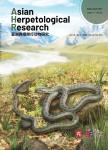Development and Characterization of 15 Polymorphic Microsatellite Markers for a Highly Adaptive and Wide-range Frog (Microhyla f issipes)
Development and Characterization of 15 Polymorphic Microsatellite Markers for a Highly Adaptive and Wide-range Frog (Microhyla f issipes)作者机构:Chengdu Institute of BiologyChinese Academy of Sciences
出 版 物:《Asian Herpetological Research》 (亚洲两栖爬行动物研究(英文版))
年 卷 期:2013年第4卷第3期
页 面:202-206页
核心收录:
主 题:Microhylafissipes microsatellite genetic diversity population genetics
摘 要:In order to analyze population genetic structure at multiple spatial scales, microsatellite loci were developed for the ornamented pygmy flog (Microhylafissipes), and 15 polymorphic microsatellite loci were successfully screened from 105 individuals, of which 82 from four populations distributed in the Sichuan Basin and 23 from the Sangzhi population in western Hunan. Five loci were found to deviate significantly from Hardy-Weinberg equilibrium in one to three popu lations, probably due to small sample size or null alleles. The average number of alleles in all loci was 8.5, ranging from 4 to 13, and the observed and expected heterozygosity ranged from 0.26 to 0.90 and 0.63 to 0.90, respectively. The Sangzhi population and the remaining four populations can be clearly separated using Bayesian clustering methods, showing that the genetic structure of M. fissipes was probably affected by the topography, especially mountain barriers. These polymorphic microsatellite loci could be used for further study on the landscape genetics of this highly adaptive and widely distributed species.



